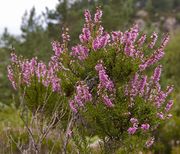Calluna
| Calluna | |
|---|---|
 |
|
| Flowering Calluna vulgaris | |
| Scientific classification | |
| Kingdom: | Plantae |
| (unranked): | Angiosperms |
| (unranked): | Eudicots |
| (unranked): | Asterids |
| Order: | Ericales |
| Family: | Ericaceae |
| Genus: | Calluna Salisb. |
| Species: | C. vulgaris |
| Binomial name | |
| Calluna vulgaris (L.) Hull |
|
Calluna vulgaris (known as Common Heather, ling, or simply heather[1]) is the sole species in the genus Calluna in the family Ericaceae. It is a low-growing perennial shrub growing to 20 to 50 centimetres (7.9 to 20 in) tall, or rarely to 1 metre (39 in), and is found widely in Europe and Asia Minor on acidic soils in open sunny situations and in moderate shade. It is the dominant plant in most heathland and moorland in Europe, and in some bog vegetation and acidic pine and oak woodland. It is tolerant of grazing and regenerates following occasional burning, and is often managed in nature reserves and grouse moors by sheep or cattle grazing, and also by light burning.
It is separated from the closely related genus Erica by its corolla and calyx each being in four parts instead of five. The flowers emerge in late summer; in wild plants these are normally mauve, but white-flowered plants also occur occasionally.
The generic name Calluna is derived from καλλύνω, a Greek word meaning 'to beautify', or 'to sweep', as the plant was used to make brooms. The specific name vulgaris is Latin for 'common'.
Contents |
Cultivation

Heather is a very popular ornamental plant in gardens and for landscaping. There are many named cultivars, selected for variation in flower colour and for different foliage colour and growing habits.
Different cultivars have flower colours ranging from white, through pink and a wide range of purples, and including reds. The flowering season with different cultivars extends from late July to November in the northern hemisphere. The flowers may turn brown but still remain on the plants over winter, and this can lead to interesting decorative effects.
Cultivars with ornamental foliage are usually selected for reddish and golden leaf colour. A few forms can be silvery grey. Many of the ornamental foliage forms change colour with the onset of winter weather, usually increasing in intensity of colour. Some forms are grown for distinctive young spring foliage.
The plant was introduced to New Zealand and has become an invasive weed in some areas, notably the Tongariro National Park on the North Island and the Wilderness Reserve (Te Anau) on the South Island, overgrowing native plants. Heather beetles have been released to stop the heather, with preliminary trials successful to date.[2]
Cultivars include ‘Beoley Crimson’ (Crimson red), ‘Boskoop’ (light purple), ‘Cuprea’ (copper), 'Firefly' (deep mauve),‘Long White’ (white).
Uses
Heather is an important food source for various sheep and deer which can graze the tips of the plants when snow covers low growing vegetation. Willow Grouse and Red Grouse feed on the young shoots and seeds of this plant. Both adult and larva of the Heather Beetle Lochmaea suturalis feed on it, and can cause extensive mortality in some instances. The larvae of a number of Lepidoptera species also feed on the plant.
Heather is an ingredient in gruit, a mixture of flavourings used in the brewing of beer during the Middle Ages before the use of hops. The use of heather in the brewing of modern heather beer is carefully regulated. By law the heather must be cleaned carefully before brewing, as the undersides of the leaves may contain a dusting of an ergot-like fungus, which is a hallucinogenic intoxicant.
Heather honey is a highly valued product in moorland and heathland areas, with many beehives being moved there in late summer. It has a characteristic strong taste, and an unusual texture. It is thixotropic, being a jelly until stirred, when it becomes a syrup (like other honey), but then sets again to a jelly. This makes the extraction of the honey from the comb difficult, and it is therefore often sold as comb honey.
White heather is regarded in some areas as being lucky, and sprigs of it are often sold as a charm.
Cultural references
Heather is seen as iconic of Scotland, where the plant grows widely. When poems like Bonnie Auld Scotland speak of "fragrant hills of purple heather', when the hero of Kidnapped flees through the heather, when heather and Scotland are linked in the same sentence, the heather talked about is Calluna vulgaris.[3]
See also
- List of Lepidoptera that feed on Calluna
References
- ↑ Matveev, Vladimir. "Ling - definition from". Biology-Online.org. http://www.biology-online.org/dictionary/Ling. Retrieved 2010-01-27.
- ↑ "Cabweb.org - de beste bron van informatie over cabweb.Deze website is te koop!". Pest.cabweb.org. http://pest.cabweb.org/Journals/BNI/Bni22-2/Gennews.htm. Retrieved 2010-01-27.
- ↑ The heather in lore, lyric and lay ... - Google Books. Books.google.com. 2008-07-22. http://books.google.com/books?id=dugpAAAAYAAJ&pg=PA6. Retrieved 2010-01-27.